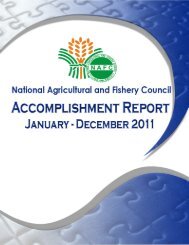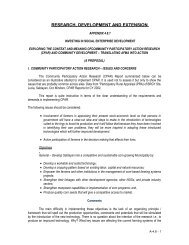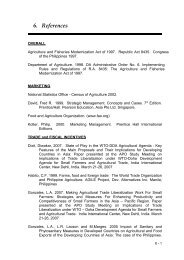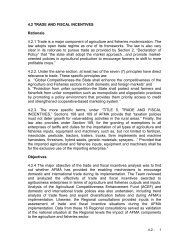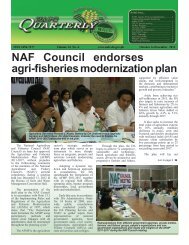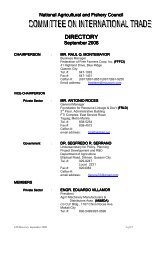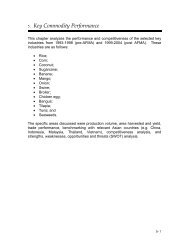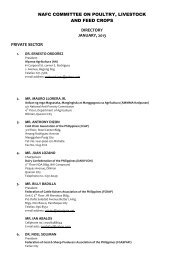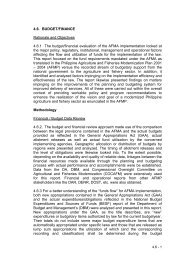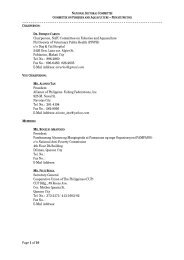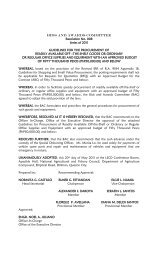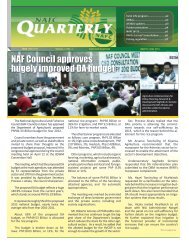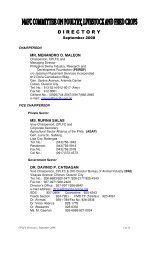EXECUTIVE SUMMARY - National Agricultural and Fishery Council ...
EXECUTIVE SUMMARY - National Agricultural and Fishery Council ...
EXECUTIVE SUMMARY - National Agricultural and Fishery Council ...
You also want an ePaper? Increase the reach of your titles
YUMPU automatically turns print PDFs into web optimized ePapers that Google loves.
1. Poverty alleviation. Agriculture <strong>and</strong> fisheries grew by almost 3.5 percent<br />
annually between 1999 <strong>and</strong> 2005, its best record since 1970s. However,<br />
rural poverty remains a challenge. The lack of resources for AFMA was<br />
contributory. The non-observance of the criteria for sound allocation of<br />
funds was not also observed, e.g. such as grains vs. tree crops trade-off.<br />
2. Food security. Agriculture growth invariably led to improved food<br />
security. Rice, poultry <strong>and</strong> fishery contributed heavily. Good weather in<br />
the 2000s also helped.<br />
3. Rational use of resources. Allocation of resources from cost-benefit<br />
analysis should be guidepost in investment. However, it appeared that<br />
production support rather than marketing <strong>and</strong> R & D were given priority.<br />
4. Global competitiveness. There were no significant product<br />
breakthroughs in the export market over the past six years. The export<br />
winners' list remained unchanged: banana, pineapple, tuna, seaweeds,<br />
carrageenan, <strong>and</strong> some coconut products. Sugar started to become<br />
competitive.<br />
5. Sustainable development has economic, social <strong>and</strong> environmental<br />
aspects. Public investment decision must be sound to sustain economic<br />
development. For instance, farm incomes, especially for coconut farms,<br />
did not increase as there was little flow of resources. Job creation could<br />
have improved if the enabling environment for private investments was<br />
favorable.<br />
Where will AFMA go from here? Agriculture <strong>and</strong> fishery are the main occupations<br />
in the rural sector. Rural poverty remains high. By government accounts, half of<br />
the rural folks are poor; while 70 percent of the poor reside in the countryside.<br />
Indeed, poverty is an agriculture phenomenon.<br />
The Philippine Farm Sector. In 2005, agriculture <strong>and</strong> fishery produced P 775<br />
billion (in gross value added at current prices). Crops contributed 58 percent,<br />
livestock <strong>and</strong> poultry 22 percent, <strong>and</strong> fishery 15 percent. By crops, palay<br />
provided 16.6 percent; coconut, 5.3 percent; banana, 4.4 percent; corn, 4.3<br />
percent; <strong>and</strong> sugarcane, 2.4 percent. Other crops (tree crops, fruits, vegetables,<br />
etc) had almost 25 percent of total output.<br />
Philippine agriculture is predominantly small, unorganized farm holdings. Crops<br />
occupied most of the farml<strong>and</strong>s. The 2002 Census of Agriculture revealed:<br />
Some 4.8 million (M) farms covering 9.7 M hectares (ha). The average<br />
farm size was 2.0 ha;<br />
Some 40 percent of the farms were less than 1 ha (occupying 8.6<br />
percent of area), 41 percent at 1 ha <strong>and</strong> below 3 ha (31 percent of<br />
area); 10.6 percent between 3 to 5 ha (18.4 percent of area), <strong>and</strong> 6.3<br />
percent, above 5 <strong>and</strong> less than 10 ha (19.8 percent of area). In effect,<br />
about 90 percent of the farmers have less than 5 ha (58 percent of<br />
area);<br />
Some 97 percent were individual farms (94 percent of area); less than<br />
0.2 percent were corporations (2.2 percent of area);<br />
ii



